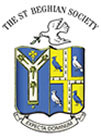|
 |
The Old St Beghian | |
| January 2020 | |||
Some OSBs will remember a collection of ancient books which were in the school library
until the 1960s. The following article is taken from the school magazine of December 1928
and describes some of the volumes which were then on the shelves.
THE OLD BOOKS IN THE LIBRARY
‘During the last two years many boys have made enquiries about the old books in the library. These books have now been examined and many are of great interest. They form one of the most unique collections of old books to be seen in Cumberland. Some of them are of interest because of their quaint titles, such as the book on Necromancy, others for their leather binding, others for the curious contemporary illustrations.
One of the most valuable is what is called the Roman Missal. Our book is not actually a Missal but is a Breviary. The Missal is the service book of the Mass, it is written in Latin, and before the days of printing it was almost invariably in the hands of the priests or monks. The Breviary was another service book, used by the monks for their vigils or prayers, which took place nearly every four hours both in the day and at night.
Our book was probably written in the late fourteenth or early fifteenth century, a little before the art of printing was discovered by Caxton. It was written on vellum and the monks laboriously worked out each letter in illuminated colours. At one time the book possessed brightly coloured medallions in gilt, but these some pirate hands have removed. The title pages of these books were extraordinarily beautiful and interwoven with bright blues and reds and gold, the general effect being one blaze of colour. Their writing took up a great deal of the time of the old monks, and was in fact one of their most important tasks.
The value of books depends upon a number of different factors: their scarcity, their interest and their state of preservation. Most of our sixteenth century books are important but of little market value. They include a large number of Calvin’s apologetics and commentaries on the Scriptures. Calvin ranks after Luther as the founder of Protestantism and was in many respects his superior. There is also an Erasmus, edited by Nicholas Udall, which is of considerable interest.
Of the seventeenth century books, Bacon’s Advancement of Learning stands out. This book was written in 1605, and was thus an early work of James 1’s Chancellor and the author of the ‘Novum Organum’. There were two copies of the work; the first a large folio edition, and a small edition, which is ours. In contrast to the staid author of the Essays we have the Carolinian poet, Sir John Suckling, with his ‘brisk round eye’ and red nose. Nephew of a Lord Treasure like Sir Francis Bacon, Suckling was a complete cavalier, addicted to gambling and the pleasures of the table. We have a small edition of his poems, which has unfortunately some blemishes.
We possess several editions of eighteenth century writers, including a complete set of the Spectator dated 1712, and a complete Addison of early date; also the second edition of Boswell’s Life of Dr. Johnson. All these books are in the most excellent condition.
It is hoped to make a deeper examination into the books and separate the good from the poor, but from a cursory survey we can already see that we possess many curious books dating over a long period of time. The experiment of showing some of these in a glass case has been made in order to stimulate interest.’
The above piece appeared in the school magazine. In the early 1960s the University of Newcastle initiated a project to record the ancient libraries which still survived in the former grammar schools in the north of England. Researchers visited these schools and made comprehensive lists of the ancient books which were still held by the schools. When the project ended, and with a view to preserving and maintaining such volumes, many of which had great historical significance, the authorities at Newcastle offered to house the books for any schools which did not feel they could look after them properly. Unlike other northern schools at the time whose ancient libraries were deposited on long-term loan, our collection of books was sold outright by the school governors to Newcastle University in the 1960s for a nominal sum, though with the stipulation that they be kept together and made available at the school for temporary display from time to time if requested.
The present writer staged just such an exhibition here in the 1990s. Some of the books are of considerable historical importance, having come from Grindal’s own library or containing contemporary annotations, and at least one is in a ‘royal’ armorial binding. It is no exaggeration to state that were this collection now to appear at auction in London, its commercial value would be very great.
There is a complete inventory of all the books which were sold in the school archives.
AJHR.
Home
The St Beghian Society
St Bees School,
St Bees, Cumbria, CA27 0DS.
Tel: (01946) 828093 Email: osb@stbeesschool.co.uk
Web: www.st-beghian-society.co.uk
![]()